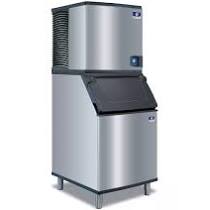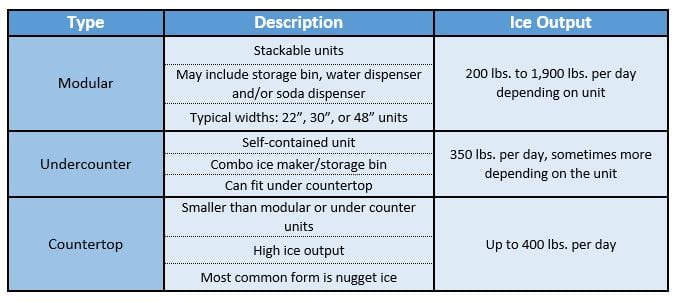
Ice machines are a crucial component of any hospital. Ice is used daily in hospitals by doctors and nurses, staff members alike– whether you’re looking for your first time around or if this will be an upgrade from what’s currently on-site! Make sure that when purchasing the perfect machine match it up with all needs – there isn’t one size fits all here so make some research into which option works best based on factors like budget etcetera before making purchases.
Types of Ice Makers for Healthcare
Many people are questioning the best types of ice machines to purchase for their hospitals. Whether you need one machine or many, it’s important that they be durable and meet your needs specifically with regards to what needs come up at any given time: injuries? Physical therapy sessions? Cafeteria food service only every now again… consider these factors when making this decision. There are two primary kinds of ice makers for hospitals.
Here’s a list:
Modular / Stackable Ice Makers:
A modular ice machine is the best choice for hospitals that need to produce a lot of ice daily. Modular machines can make up to 300 pounds per day, and stacking them will allow you to triple or quadruple your output.

These machines are the perfect solution for commercial properties such as restaurants, bars, and hospitals. They can produce ice in much larger quantities than under-counter models which makes them a great choice when it comes time to serve large groups or stock up during an event.
These modular machines are perfect for any ice storage need. The bin can be filled with cubes of varying shapes and sizes, or you could purchase an entire machine without bins if that’s what is more suitable for your application.
In order to ensure that the ice is always cold and available for customers, modular hospital-sized machines are perfect. These types of refrigerators use bins filled with blocks that can store up to 3000 lbs per day! They dispense water directly into your drinks or other food items so you never have an empty glass again – they’re also popular in facilities where there’s a lot going around like cafeterias because this type of model has smaller size options from 50lbs all the way down liners weighing less than 100 pounds.
Countertop or Commercial Ice Makers:
Ice dispensers are perfect for visitor use but not hospital staff. They produce their own ice and a user can easily dispense it into whatever cup they like without having to rely on using up all the available liquid in your drink with just one scoop! You even get smaller countertop models or commercial-sized ones; which will give you more room at home plus put out larger amounts of frozen slush each time compared with residential sized machines that only hold 1/2 cups worth by volume–so there is no excuse if I don’t visit often enough because this way, my drinks always stay cold.

Lifespan: People are often wondering how long an ice machine will last. Factors such as the amount of use and maintenance affect their longevity, but most likely not in a good way. A 10-year lifespan is possible with careful care (4 to 5 years), though it’s safe to estimate would be closer to 4 or 5 if you rarely use your cooler more than once per week for short periods of time.
Energy Use: The energy used by the hospital’s countertop ice makers can be around 350 kWh per month, at a typical rate of $0.07 for each kilowatt-hour (kWh). That would add up to about 21 dollars spent on electricity every 30 days. This is much less than the cost you’d pay if your refrigerator or freezer broke down–more than two grand just because it has an inefficient cooling system.

Types of Ice
When considering which type of ice machine to purchase, it’s important not only that you find the right model but also one makes the type of ice for the specific need.
There are a few types of ice, but here’s a list of the most popular ones used in healthcare and hospital facilities.
Regular/Half Cube Ice:
Your typical freezer cubes are meant for quantity, not quality. You likely enjoy them in everything from teas to cocktails and they can also be crushed into pieces if you’re not looking to win an award of sorts.
A lot of people will use these as their standard ice crafters because it gets the job done – but hey: there’s always room on top of our list for more aesthetically pleasing options like sphere-shaped or powdery snow-like crystals instead.
Crushed Ice:
Crushed Ice is the perfect drink for those who like their drinks to be cold and refreshing. It can either be crushed finely or coarsely depending on your preference!.
If you don’t have a crushed ice option, the best tactic is to wrap freezer-sized pieces in clean towels and carefully break them. You can also find this fluffy slushy kind on fountains machines.
For those looking to make slushy drinks, crushed ice is the perfect ingredient. It can be used in place of other types and will not clog your blender blade as easily when making a frozen drink and restaurants.
Flake Ice:
Flake ice is a very popular option for hospital patients. It’s the best kind to have because it doesn’t slice through plastic bags and injuries can be better treated with this type of soft ice than other forms that might cut up skin or bones, like hard cube ices which often need more time in order dissolve them before they’re comfortable enough on their injured selves again after being cracked by something sharp inside one’s mouth (like toothbrushes).
Flake ice is a softer, chewier variety of legendary cubes. Not only does it have less structure so you can mold it into any shape needed for icing wounds on hard-to-ice areas such as knees and elbows–but its consistency also means that flakes will slice through bags with ease.
Nugget Ice:
Some would say that nugget ice is better than flake because it’s bigger and chewier. However, these same people might add they are easier on your teeth since you can bite into them harder without worrying about breaking a tooth.
Unlike cubed ice, nugget ice has a soft and chewable texture. Patients with swallowing difficulties can easily break off small pieces of the frozen treat to stay hydrated while still being easy on their teeth since it’s easier than chewing melted-down snow into a more manageable form for everyday use. While not as moldable or pliable at times–it cools elbows & knees much faster too.
| Type | Characteristics | Purposes For This Ice Type |
|---|---|---|
| Cubed Ice | Cubed Shape | Iced Beverages |
| Slow Melting | Most Commonly Used Ice Form | |
| Weight: 0.17 – 0.5 oz | Frequently used in Restaurants, Bars, Convenience Stores, Hotels, Offices. | |
| Nugget Ice | Pellet Shape | Iced Beverages |
| Softer, Chewable Ice Form | Add texture to drink experience | |
| Also called “chewblet” or compressed nugget ice | Frequently used in Restaurants, Bars, Fast Food, and Healthcare Facilities. | |
| Flake Ice | Shaved Flake Shape or Crushed Form | Commonly used for preserving, packing, and cold storage |
| May Contain up to 1/5 liquid | Not Intended for Human Consumption | |
| Fast Melting | Frequently used in Fish- and Meat-Packing, Grocery Stores, Research Facilities. |
Th
What Size Ice Makers Should Hospitals Use?
To figure out the size of your hospital ice maker, you will need to know how many pounds per day it is expected for that particular model. If this sounds like something in which you’re not entirely confident or have no idea what any of these measurements mean then don’t worry. There are ways around both problems – here’s one: measure out an area where there isn’t already space allocated by making certain assumptions about volume (in cups) and multiply those numbers together until they equal 1kg/square meter; now divide through hundred sections instead (.25 lbs).
You may be surprised to learn that the average hospital patient in America requires 10 lbs of ice per day. But how many people do you normally have visiting or working at your facility? That’s on top of all those needs for staff and visitors like yourself-in addition to physical therapy prescriptions.
Scheduled Ice Machine Maintenance
Hospitals should invest in an ice machine that has a yearly maintenance service. The first thing you need to do when buying any new appliance, even if it’s just for yourself at home or as part of your commercial business is to call the manufacturer and find out what kind of cleaning solutions they recommend.
Maintenance can be done daily, however, it’s generally done monthly, or weekly for extreme high-volume icemaking need.
If you’re going to have an ice machine, it’s important that your supplier performs routine maintenance at a frequency determined by them. When buying from them make sure–in advance!–to ask about when they will perform these services and how often in order for us as customers not get behind on our scheduled appointments with this vendor.
How Much Do Icemakers Cost For Hospitals?
The national average cost for a hospital ice machine will range between $3900 – $10,160. Your cost will be according to the volume of ice you need to produce, the type of ice maker you need, and rather or not you buy a new or used one.
Ice Maker Depot’s mission is to help hospitals look after their patients by providing the ice that people love. Healthcare facilities find they can save money on overall operating costs and total cost of ownership when giving patients cube, nugget, or flake-style ices instead of just crushed ones since it will last longer in any case.
Hospital ice machines come in different shapes and sizes to meet your needs. The type of hospital-grade cooler you choose can help keep patients cool, as well as make things easier for staff members who work hard on a daily basis!
4 Benefits of Ice Machines for Hospitals
Hospitals need an ice machine for a few reasons. For starters, think about how many hours the staff and patients spend in their hospital day-in and day-out! A place like this can become very comfortable over time – so it makes sense that they would provide cold snacks or drinks available all throughout as part of hospice care. Other than providing comfort food items on site; hospitals also use these machines because some people who visit may have certain medical conditions where there is no other way around having access to fresh frozen water at any given moment. Here are four benefits of having icemakers in the hospital.
- Cold beverages for doctors, nurses, and patients
- Hydration sick and ill patients
- Reducing swelling with ice bags
- Physical therapy
Where to Place Ice Makers in Hospitals
When considering where to install a hospital ice machine, it’s important that you think about what type of access is needed. For patient care areas in particular, doctors and nurses will want easy accessibility so they can provide the best service possible for those who rely on them most.
There are several common locations or healthcare facilities would install their ice machine. Here’s a list:
- Café / Cafeteria
- Waiting Room
- Nurses Station
- Safe location on each floor
In the event that you’re looking for an ice machine to place in common spaces like waiting rooms and cafeterias, it may be beneficial if they can easily be accessed by staff members. You will also want to make sure there’s one nearby where nurses are working on each floor of your building so everyone has access-no matter their location.

